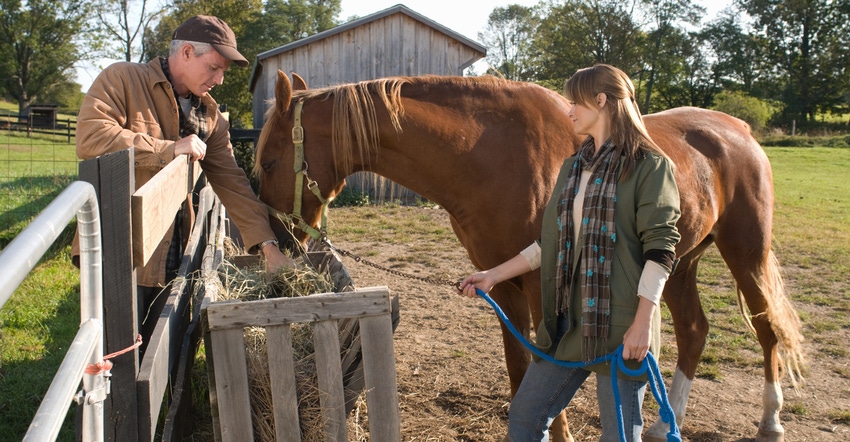July 9, 2021

Most of today’s horses are nowhere near the active workhorses they were back in the 1800s. They’re not pulling plows for 10-plus hours and their caloric requirements to produce energy is not nearly what it used to be, as pointed out by Valley Vet Supply, which was founded in 1985 by veterinarians to provide customers with the animal health solutions.
So, if you’re feeding the same concentrated grain meal introduced centuries ago, it’s time to rethink that practice. “If you take a high-starch feed like that and overfeed them, you can make a horse very excitable or crazy,” says Jyme Nichols, director of nutrition at Stride Animal Health, during an interview with Valley Vet Supply.
Equine nutrition is complex. However, Nichols warns there is plenty of “sugar coating” when it comes to our horse’s grain choices, and that along with high starch are just a few aspects to consider relating to a horse’s nutritional program.
With insight from Nichols, here are some frequently asked questions about horse nutrition:
Does my horse need supplements? The answer to that is never black or white. It depends on what you are doing with your horse; how old your horse is; whether you’re feeding your horse a forage-only diet, or whether your horse is on feed. It also depends on if your horse is dealing with certain problems, like if they have arthritis, gut issues or specific needs that are outside of what we would consider normal, more basic nutritional needs.
Does protein make horses hot? No, it doesn’t. It is the starch and sugars in what you are feeding that make horses hot. There is some confusion about protein. It’s commonly thought that horses need more feed, more protein and more nutrients, so we’re going to feed this higher-protein feed. But what owners may not realize, is that when they were feeding that higher-protein feed, they were also feeding more of it. It wasn’t necessarily the high protein that was making the horses become excitable. It was the fact they were feeding a really large volume of a high-starch, high-sugar feed.
Nutritionally, how can I manage or prevent a “hot” horse? If you have a horse that is naturally more excitable and anxious, one of the better things you can do is look for a diet that is high in fiber and pull your calories from fat sources. Those fat sources are called “cool-energy calories,” meaning it gives horses the calories that they need, but it’s not going to make their mind and their attitude hot and excitable.
For energetic horses, avoid high-starch feeds. Refer to the feed tag for the “NSC,” which is the combination of starch plus sugar. NSC stands for non-structural carbohydrates. You get to that number by adding the starch number on the feed tag to the sugar level. As a general rule of thumb for feeds considered “low starch,” if you were to add the starch and the sugar together, that number shouldn’t be over 22%.
Can sugars impact certain horse health conditions? For horses with pituitary pars intermedia dysfunction (PPID), or equine Cushing’s disease, starch and sugar are really important in the diet to help manage. If you have a horse with a medical sensitivity, such as a horse with Cushing’s, laminitis or equine metabolic syndrome, the medical sensitivity to sugar means you need to make sure that your NSC is under 12%. After that, you want to make sure you’re feeding at the recommended levels of the feed. If you’re not — and let’s say that particular feed calls for 6 pounds per day and you’re only feeding those horses 3 pounds per day — you’re shorting them in important trace minerals or vitamins.
How do you nutritionally manage a horse that ties up frequently? There is not a generic answer. But keep horses off green grass, which has higher sugar content; feed low-starch, low-sugar feed; and make sure you have a proper balance of trace minerals, macronutrients and vitamins. Also, ensure they have daily exercise.
How do I know if my hay is meeting their basic needs? First off, do a visual check and body condition assessment of your horse. Look at rib cover — you should be able to easily feel but not easily see ribs.
Next, you’ll want to look at the topline. You want the horse’s topline to be essentially flat. If they can hold water on their spine on a rainy day, that tells you they’re in a bit of an excess body condition. But if rain were to pour on them and just run off, and their spine peaks up like a mountain, that tells you their body condition is probably a bit under.
But the most concrete thing you can do is get your hay tested. Getting that information is the most important thing you can do, because forage is the foundation of your horse’s diet, and it is so important to understand what you are feeding.
Source: Valley Vet Supply, which is solely responsible for the information provided and is wholly owned by the source. Informa Business Media and all its subsidiaries are not responsible for any of the content contained in this information asset.
You May Also Like




